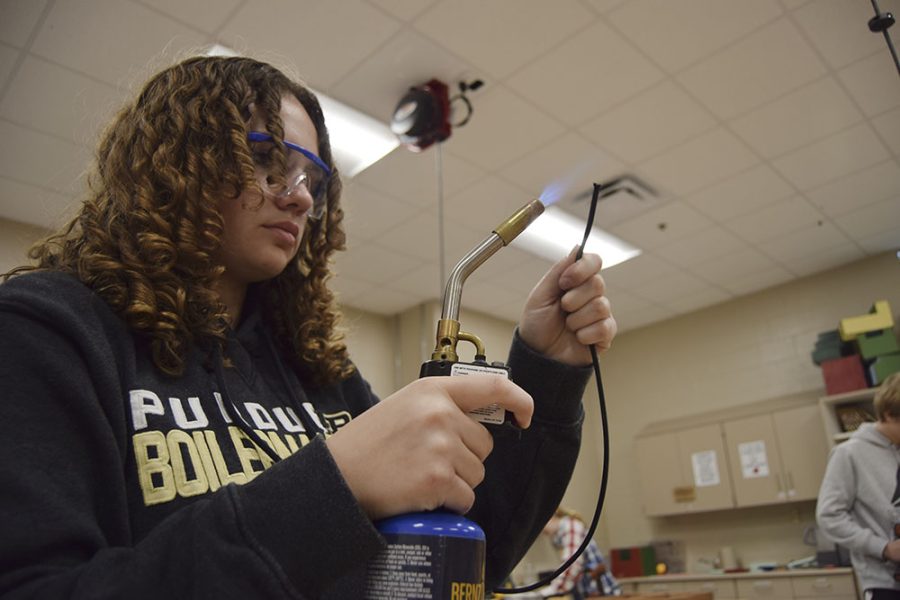The future is female: The next generation of innovators is here
April 12, 2023
Traditionally, science has been a man’s world. But that view is changing. Despite the many obstacles before them, these trailblazing women at NHS are opening new pathways in the world of STEM, for future students, as well as continuing the work of the women who came before them.
Science:
Sydney Elliott has taken advanced courses in the STEM field throughout high school, specializing in science. The junior has noticed that her classes at NHS usually comprise a significant number of females.
“At Noblesville, there is a lot of female participation in STEM courses. I know this is absolutely not the case at other schools, but it is encouraging to see it here,” Elliott said.
Although Noblesville’s STEM program is inclusive for girls, according to Elliott, outside of the school building is where opportunities for women becomes tricky. But rather than seeing this inequality as a downside, she uses it as inspiration.
“Outside of NHS, personally, I see the male domination of this field as a challenge,” Elliott said.
According to Elliott, female presence in STEM fields is a step on the way to the equality women have long been trying to achieve.. Seeing females fearlessly take control of fields not inclusive of women has made an impact on her.
“I am inspired by women who defy stereotypes placed on them by their male counterparts,” Elliot said. “I think it’s really great that more women are going into STEM programs and taking classes such as AP chem. I think it’s really exciting, I’m glad to be a part of it.”
Elliott believes the importance of recognizing the ability women possess in these fields stretches beyond high school. It is something that can impact women in college, in their careers, and after.
“Science and medicine is a field I am thoroughly interested in,” Elliott said, “and I am not going to let a current lack of female participation drive me away from my goals.”
Technology:
The course that Alexia Espinoza enrolled in is titled AP Computer Science Principles (APCSP). While the NHS junior says she loves the subject, she also says she’s had some isolating experiences in the class, similar to other women in STEM.
“I think there’s about six girls and the rest are guys. And you [have] to keep in mind, it’s like, five full rows of all guys,” Espinoza said.
Espinoza’s classes have an approximate 1:5 ratio of females to males.. According to Espinoza, while most male peers are kind and willing to help, some can be difficult to be around, even discouraging her from asking for help from fellow classmates.
“I had a problem at the beginning of the year [that] was because of this one guy. He’s really smart. And he likes to show it. So I asked for help, and he made me feel so stupid.”
Because of how this incident affected her, Espinoza has formed her own philosophy towards the classroom. She thinks her experience can be a common one, so it’s an important belief of hers.
“If [someone is] asking you for help, you shouldn’t make [them] feel stupid about asking for help,” Espinoza said.
Despite Espinoza’s occasional negative experiences, she’s still adamant that everyone deserves the opportunity to learn, and experiment with the classes that interest them.
“You’re very capable of learning a lot of things, and doing a lot of things,” Espinoza said, “so don’t be afraid to.”
Engineering:
Engineering classes have been part of senior Daniella Tuesca’s four years of high school through Project Lead The Way (PLTW). According to Tuesca, as the classes get more and more rigorous, girls begin dropping the courses.
“I think it’s just how the STEM classes [seem] so unapproachable. There are just no girls. And it only decreases as classes get more advanced.” Tuesca said. “It’s not that girls all of a sudden aren’t interested in engineering, but they kind of get shot down by other students.”
Women still want to explore STEM as a field, but they fewer chances to do that compared to their male counterparts. Several factors contribute to this, but Tuesca sees some common occurances that might push girls away from these courses.
The first, she says, is that students sometimes don’t always know exactly what they’re getting into. Even in introductory classes, it can be difficult for students to adjust to the curriculum.
“So if you take the Intro to Engineering class, and you don’t know what you’re doing, you don’t know what the focus is, you’re not gonna like it,” Tuesca said.
Another factor she’s noticed is the social environment of the class. Despite the fact that the female to male student ratio is often close to equal, Tuesca believes that women’s opinions and ideas often get put on the back-burner, even in classes where there are just as many women as men.
“I remember it was me, and then like, two guys,” Tuesca said. “I felt like [I was] kinda on the back end. It was only [the boys] talking. And I was left out, put to the side.”
Although Tuesca’s path has been difficult and full of challenges, she’s now well on her way to her dream of becoming a mechanical engineer.
“Trust your gut,” Tuesca said. “If you think that you want to go into engineering, if you think that you like computer principles, don’t let anyone tell you that you should go somewhere else.”
Math:
Many sophomores would be intimidated by the workload required by multiple math classes in the same year. But not Kymaia Edge, a sophomore who claims she’s not one to take the easy way out. Balancing two STEM classes can be hard, especially when battling the many other obstacles of high school. Between Edge’s involvement in Precalculus and AP Statistics, the work can pile up quickly, and things can get complicated, she says. The real challenge for Edge lies with being a woman in an underrepresented field. While the ratio of men to women is not significantly different from most of her other courses, the attitude in her STEM classes is where Edge says the difference stands out.
“They’re more outspoken in their classes,” Edge said. “I feel like they tend to believe that they know the answers or that they have a better understanding of the concepts.”
Edge believes that while men have a confidence advantage in higher-level science and technology courses, they often don’t know what their female peers are capable of.
“It’s not that they underestimate women, it’s just that they have no idea what kind of skill set women have,” Edge said.
While being a female in an advanced math course is hard enough, Edge also was challenged with being one of the youngest women there. However, she found that the social equation in front of her was not a hard one to solve.
“I found that they were really friendly,” Edge said, “I was quick to make friends in that class. A lot of my classmates were super nice.”
Along with her academic drive to keep her atop, Edge credits her teachers for a significant part of her success.
“I feel at Noblesville you can rely on your teachers a lot,” Edge said. “They’re always available for [assistance] as well, and they work really hard to make sure there are people who can help.”
Even as STEM fields open up further opportunities for female students, some specific courses, like engineering and computer science, remain male-dominated. Females in these courses say issues with outright sexism in STEM classes are significantly less prevalent at NHS than they used to be, but many still feel a lingering sourness, whether the other students know it is there or not.
Lisa Heid has been teaching computer science-related courses at NHS her entire career. Beginning with her own experiences in college, she has observed the heavily male dominated state of STEM fields in her own life, and now in the lives of her students.
“I was in college in the mid ‘90s, and in my business classes, the ratio was 50/50. I had to take an elective, and I chose computer science,” Heid said. “In that class, I was one of the only girls, so not much has changed since then.”
This gap in the STEM field has yet to improve, and Heid recognized it from an early point.
“I’ve been teaching technology for 25 years, and it’s just been either all men, or extremely male-dominated. I’m starting to get a few more girls, but the ratio has to be 90% boys,” Heid said.
While these concerning numbers present visible issues, students are not the only ones to notice. Andy Wilkins, chair of the applied STEM department, believes that staff involvement in making this field as equal as possible is key to the success of the program.
“What we started this year is making sure that in our intro class for engineering, we try to make classes have a 50/50 ratio, or more girls than boys,” Wilkins said.
Along with Wilkins, STEM teacher Elizabeth Muller sees a positive difference between her time in college versus now. Since 2018, she has been a role model for young women taking STEM classes at NHS. According to Muller, while in college she felt as if she did not have a voice, and felt overshadowed by her male peers.
“It has definitely changed a lot. My classroom has about 70% women and 30% male students. Historically, the classes have been like 90% male students, 10% female students. It’s a completely different environment,” Muller said.
Jason Francis, a professor and web programmer at Indiana University, has a similar take on the issue. Rather than seeing his students as specifically women or specifically men, he views them simply as people. This can mean promising things for the future of women in STEM.
“[Out of] the students who enroll in my class, the men are more likely to be pursuing STEM majors than the women,” Francis said. “[However,] whether or not a student scores well in my class seems to be independent of major or gender.”
Although women in STEM fields throughout college seem to be more prevalent as time goes on, Heid believes there is a pressing issue with garnering interest in STEM fields in high school. According to Heid, when young girls see a class of almost entirely boys, it gives them a sense of doubt, like they should not be there.
“It’s intimidating. Technology is known to be a man’s field, so trying to get girls interested in it, you have to focus on the creative side,” Heid said.
This issue isn’t just relevant in high school. The urge to pursue STEM classes often starts at an early age, and is vital for future generations of women innovators.
“There are a lot of great elementary school science introductory courses,” Heid said. “Starting it early and keeping it going through middle school would be a great idea.”
Muller agrees. She has some valuable advice for women who are thinking of entering the STEM field.
“Even if it seems that you don’t have what it takes, trust yourself. You are smart. You are strong. You have a great voice – speak it. The best thing you can do is to just go for it because you’ll thank yourself later.”







